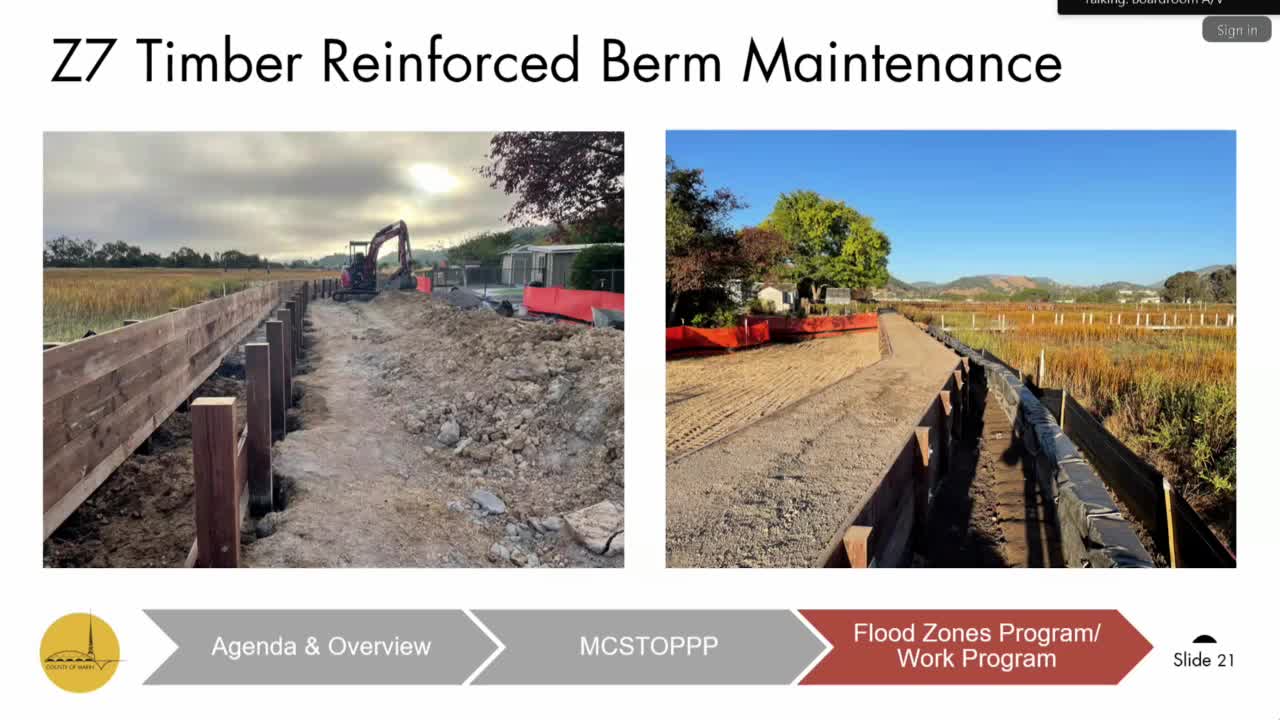Fairfax County allocates over $500K for flood zone habitat restoration and monitoring
May 21, 2025 | Marin County, California
This article was created by AI summarizing key points discussed. AI makes mistakes, so for full details and context, please refer to the video of the full meeting. Please report any errors so we can fix them. Report an error »

In the heart of Marin County, a pivotal government meeting unfolded, shedding light on the pressing issues surrounding flood management and environmental stewardship. As officials gathered, the atmosphere was charged with urgency, reflecting the challenges posed by aging infrastructure and increasing environmental regulations.
The meeting highlighted the critical need for maintenance and management of flood control facilities, many of which were constructed decades ago. Officials reported that the existing funding is insufficient to meet the growing demands for repairs and rehabilitation. “Our infrastructure is aging and requires significant maintenance,” one speaker noted, emphasizing that the operations and maintenance (O&M) needs are more extensive than ever. This situation is compounded by the rising costs associated with environmental compliance, which are straining the baseline budget.
A significant focus was placed on the Sunnyside Detention Basin in Fairfax, where habitat restoration efforts are underway. Before-and-after photos showcased the progress made through mitigation planting, a process that will require active management for at least five years. The estimated cost for ongoing management at this site alone exceeds half a million dollars, underscoring the financial burden of environmental stewardship.
As discussions progressed, officials acknowledged that the flood control district is particularly affected by stringent environmental regulations. Many projects are situated in sensitive areas, such as wetlands and creek-adjacent zones, which heighten the complexity and cost of compliance. “Most of our projects are either in a wetland or adjacent to a creek,” one official remarked, highlighting the environmental challenges that accompany flood management efforts.
The meeting also addressed the baseline budget, which encompasses essential activities necessary for maintaining flood control operations. This budget includes labor costs for project management, environmental compliance, and ongoing maintenance of infrastructure. With an increase in project loads anticipated, officials warned that the baseline budget would need to expand to accommodate these demands.
In a revealing moment, the financial outlook was presented, showing a projected increase in fund balance of approximately $4.7 million. However, this figure may be misleading, as it does not account for the substantial costs associated with capital improvement projects, estimated at around $4.2 million for the upcoming year.
As the meeting drew to a close, the officials left with a clear understanding of the challenges ahead. The need for a robust and adaptable approach to flood management and environmental compliance is more critical than ever. With aging infrastructure and rising costs, Marin County stands at a crossroads, where proactive measures will determine the resilience of its flood control systems and the health of its natural habitats. The discussions held in this meeting will undoubtedly shape the future of the county's environmental and infrastructural landscape.
The meeting highlighted the critical need for maintenance and management of flood control facilities, many of which were constructed decades ago. Officials reported that the existing funding is insufficient to meet the growing demands for repairs and rehabilitation. “Our infrastructure is aging and requires significant maintenance,” one speaker noted, emphasizing that the operations and maintenance (O&M) needs are more extensive than ever. This situation is compounded by the rising costs associated with environmental compliance, which are straining the baseline budget.
A significant focus was placed on the Sunnyside Detention Basin in Fairfax, where habitat restoration efforts are underway. Before-and-after photos showcased the progress made through mitigation planting, a process that will require active management for at least five years. The estimated cost for ongoing management at this site alone exceeds half a million dollars, underscoring the financial burden of environmental stewardship.
As discussions progressed, officials acknowledged that the flood control district is particularly affected by stringent environmental regulations. Many projects are situated in sensitive areas, such as wetlands and creek-adjacent zones, which heighten the complexity and cost of compliance. “Most of our projects are either in a wetland or adjacent to a creek,” one official remarked, highlighting the environmental challenges that accompany flood management efforts.
The meeting also addressed the baseline budget, which encompasses essential activities necessary for maintaining flood control operations. This budget includes labor costs for project management, environmental compliance, and ongoing maintenance of infrastructure. With an increase in project loads anticipated, officials warned that the baseline budget would need to expand to accommodate these demands.
In a revealing moment, the financial outlook was presented, showing a projected increase in fund balance of approximately $4.7 million. However, this figure may be misleading, as it does not account for the substantial costs associated with capital improvement projects, estimated at around $4.2 million for the upcoming year.
As the meeting drew to a close, the officials left with a clear understanding of the challenges ahead. The need for a robust and adaptable approach to flood management and environmental compliance is more critical than ever. With aging infrastructure and rising costs, Marin County stands at a crossroads, where proactive measures will determine the resilience of its flood control systems and the health of its natural habitats. The discussions held in this meeting will undoubtedly shape the future of the county's environmental and infrastructural landscape.
View full meeting
This article is based on a recent meeting—watch the full video and explore the complete transcript for deeper insights into the discussion.
View full meeting
